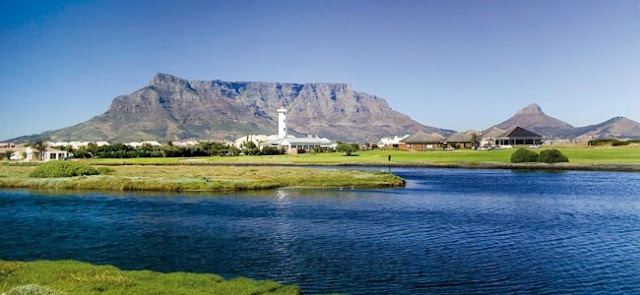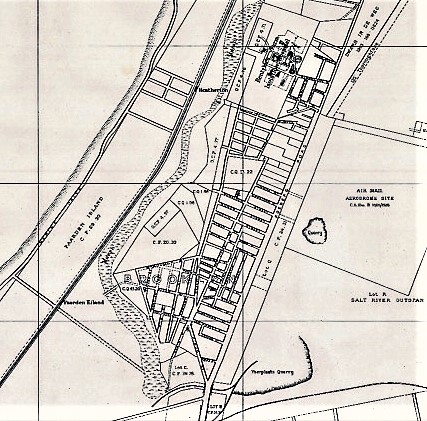The Milnerton Lagoon: Part 1
The Milnerton lagoon is,
in actual fact, the lower reaches of the Diep River, which rises in the Riebeek Kasteel mountains 65 km
north-east of Cape Town and flows through the wheat-producing areas of the Swartland before entering the Rietvlei wetland
and then emptying into the sea at Milnerton. It has one major tributary, the Mosselbank, which drains the northern slopes of the Durbanville hills. Other tributaries include the Swart, Groen, Klein, and Riebeeck, with the Klapmuts being a tributary of the Mosselbank.
The Diep River did not originally flow
into Table Bay at its present outlet, but continued inland, where there was a
confluence with the Salt River, thereby forming a far wider estuary than either
of the rivers has today. The map below, drawn in 1656, gives a rough idea of
the Diep’s original course. The arrow indicates the site of the wreck of the Nieuwe Haerlem, mentioned in a previous blog.
The original course of the Diep River can be seen at the top right, wending its way towards the wide Salt River estuary (spanned by the bridge).
An entry in Jan van Riebeeck’s journal for 29 January 1659 records
an expedition to look for salt along the river which he called Hollants Rietbeecq, today’s Diep River. This river, and the Rietvlei wetland into
which it flows, used to dry up during the summer months, with the estuarine
lagoon becoming hypersaline and depositing salt in the Rietvlei marshes, the
locality of the deposits of sghoon wit zout
(pure white salt) mentioned by Hondius.
Salt deposits along the shore of Rietvlei
The VOC outpost at Rietvlei (named Riet Valley by the VOC) was established in about 1660. The outpost included a residence, a lave house and a dairy, operated on behalf of the Cape Governors, with a subterranean milk room. Wolraad Woltemade, a VOC dairyman better known for his heroic rescue and death, is believed to have been employed in this dairy. Thatching reed in the area was cut for the Company’s buildings in Cape Town.
The VOC outpost at Rietvlei (named Riet Valley by the VOC) was established in about 1660. The outpost included a residence, a lave house and a dairy, operated on behalf of the Cape Governors, with a subterranean milk room. Wolraad Woltemade, a VOC dairyman better known for his heroic rescue and death, is believed to have been employed in this dairy. Thatching reed in the area was cut for the Company’s buildings in Cape Town.
During the first British Occupation of the Cape, the site continued to
be used as a camp for Khoekhoe soldiers. At the time of the Battle of
Blaauwberg, the site was used as a base for General Janssens and his troops.
Beginning in May 1973, the north-west section of the vlei was dredged to a depth of 9 metres (30 ft). Seawater was pumped into the pans to facilitate this operation, resulting in a total change to the ecological character of this portion of the system. A large portion of the shallow ephemeral pans was converted into a deep-water lake.
Dredging operations at Rietvlei
Official recognition of the importance of Rietvlei to biodiversity was first afforded by the South African government in 1984, when it was established as a Nature Area. This was followed by its declaration as a Protected Natural Environment in 1989, and the establishment of the Rietvlei Wetland Reserve in 1993.
Dredging operations at Rietvlei
Official recognition of the importance of Rietvlei to biodiversity was first afforded by the South African government in 1984, when it was established as a Nature Area. This was followed by its declaration as a Protected Natural Environment in 1989, and the establishment of the Rietvlei Wetland Reserve in 1993.
173 species of bird have
been recorded at Rietvlei, of which 102 are waterbirds and 76 are present regularly. Breeding has been
confirmed for 23 waterbird species and
is suspected for a further 13. The high diversity of waterbirds is due to
the wide range of wetland habitats present and the proximity of Rietvlei to
the ocean, which allows both freshwater and coastal species to exploit
the system. Fluctuating water-levels are intrinsic to Rietvlei’s biological
value. During peak floods, swimming birds of deep, open water abound. Birds of
marshy habitats replace these as the water recedes, and waders exploiting shallow mudflats occur just prior to the wetland drying up. Rietvlei has been
ranked as the sixth most important coastal wetland in South Africa for waterbirds, and it supports
an average of 5,550 birds in summer; during good years, however, numbers are
boosted above 15,000.









Comments
Post a Comment